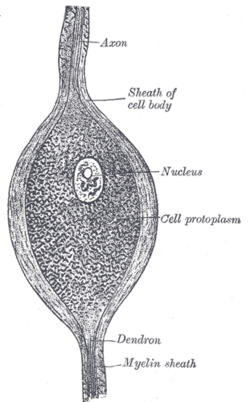Bipolar neuron
A bipolar neuron or bipolar cell, is a type of neuron which has two extensions (one axon and one dendrite). Bipolar cells are specialized sensory neurons for the transmission of sense. As such, they are part of the sensory pathways for smell, sight, taste, hearing, touch, balance and proprioception. The other shape classifications of neurons include unipolar, pseudounipolar and multipolar. During embryonic development, pseudounipolar neurons begin as bipolar in shape but become pseudounipolar as they mature.[1]
| Bipolar neuron | |
|---|---|
 Bipolar nerve cell from the spinal ganglion of the pike. | |
| Details | |
| Identifiers | |
| Latin | neuron bipolare |
| TH | H2.00.06.1.00050 |
| Anatomical terms of neuroanatomy | |
Common examples are the retina bipolar cell, the ganglia of the vestibulocochlear nerve,[2] the extensive use of bipolar cells to transmit efferent (motor) signals to control muscles, olfactory receptor neurons in the olfactory epithelium for smell (axons form the olfactory nerve), and neurons in the spiral ganglion for hearing (CN VIII).
In retina
Often found in the retina, bipolar cells are crucial as they serve as both direct and indirect cell pathways. The specific location of the bipolar cells allow them to facilitate the passage of signals from where they start in the receptors to where they arrive at the amacrine and ganglion cells. Bipolar cells in the retina are also unusual in that they do not fire impulses like the other cells found within the nervous system. Rather, they pass the information by graded signal changes. Bipolar cells come in two varieties, having either an on-center or an off-center receptive field, each with a surround of the opposite sign. The off-center bipolar cells possess excitatory relationships with the synapses and are hyperpolarized by light. On-center bipolar cells have inhibitory synapses and therefore are excited by light and suppressed in the dark.[3]
In vestibular nerve
Bipolar neurons exist within the vestibular nerve as it is responsible for special sensory sensations including hearing, equilibrium and motion detection. The majority of the bipolar neurons belonging to the vestibular nerve exist within the vestibular ganglion with axons extending into the maculae of utricle and saccule as well as into the ampullae of the semicircular canals.[4]
In spinal ganglia
Bipolar cells are also found in the spinal ganglia, when the cells are in an embryonic condition.
Sometimes the extensions, also called processes, come off from opposite poles of the cell, and the cell then assumes a spindle shape.
In some cases where two fibers are apparently connected with a cell, one of the fibers is really derived from an adjoining nerve cell and is passing to end in a ramification around the ganglion cell, or, again, it may be coiled helically around the nerve process which is issuing from the cell.
Additional images
 Retinal Bipolar Cell
Retinal Bipolar Cell
References
- Vanderah, Todd W. (2015). Nolte's The Human Brain : An Introduction to Its Functional Anatomy. Gould, Douglas J., Nolte, John. (7th ed.). Philadelphia, PA. ISBN 9781455728596. OCLC 895731173.
- Bipolar+cell Archived 2016-04-03 at the Wayback Machine at eMedicine Dictionary
- "David Hubel's Eye, Brain and, Vision". Archived from the original on 2018-07-20. Retrieved 2014-05-06.
- Clinically Oriented Anatomy
This article incorporates text in the public domain from page 722 of the 20th edition of Gray's Anatomy (1918)